Tag: Gulliver
Heathrow Airport may suffer further delays before it gets a third runway
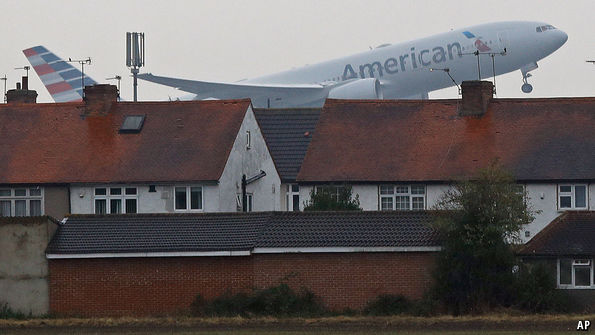
CHAMPAGNE corks must have been popping yesterday at London Heathrow, Europe’s busiest airport, as the British government finally gave it the green light to build a third runway. The decision has been a long time coming. The airport, has been operating at 99% of its capacity for a decade.
No new full-scale runways have been built in south-east England since the second world war because of government dithering. More than a dozen commissions, policy documents and white papers investigating how to expand capacity around the capital have come and gone since the first proposal to build a third runway at Heathrow in 1946. Those plans were defeated by NIMBYs, tight budgets and legal challenges. But just like the thick fog that enveloped Heathrow this morning, the path to expansion is still murky.
The first obstacle is political. Although members of the British government’s aviation sub-committee were unanimous in their support for expansion at Heathrow rather than Gatwick, its arch competitor to the south of London, not everyone in the cabinet is convinced. Many west London MPs vociferously oppose expansion, including Boris Johnson, the foreign secretary, who once…Continue reading
An American airline wins the right to weigh passengers on its Samoan route

ONE of Gulliver’s stranger flying experiences came in 2011, when he was preparing to board a domestic flight from Panama City to the beaches of Bocas del Toro. An airline employee motioned to a scale, and Gulliver dutifully placed his bag on it. “No,” she said, and in a conversation combining her broken English with his broken Spanish, communicated that, in fact, he himself was the item she wanted to weigh. The plane, it turned out, had only about six seats, and it was crucial to achieve a weight balance.
Now an American airline is in trouble for a similar practice on a, well, much larger scale.
The problem for Hawaiian Airlines began when the carrier discovered it was burning through more fuel than anticipated on its route between Honolulu and the small Pacific island territory of American Samoa, according to reporting by the Associated Press. The airline ruled out explanations like strong winds and decided to conduct a voluntary survey among its passengers on the route. The results were clear:…Continue reading
American airlines can no longer ignore cheap European rivals on transatlantic routes
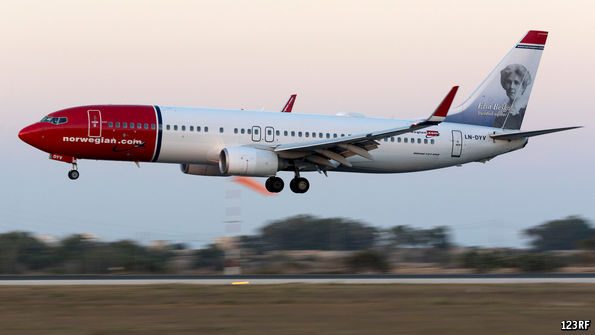
GULLIVER tried an experiment the other day: he visited Kayak, a price-comparison website, plugged in some random dates in December, and looked for flights between New York and Berlin. The lowest fare that came up was a modest $387, with Norwegian Air Shuttle. The second-lowest fare was $419, also with Norwegian. After that came several flights combining legs on Norwegian and other airlines, including easyJet and Iceland’s WOW air, and a full itinerary on WOW. Only after scrolling through nearly two pages of results did the cheapest fare not involving one of these low-cost airlines appear: a $742 itinerary on Aer Lingus.
The lowest fare on an American airline didn’t show itself until page 19 of the results. That round-trip flight, with United, was selling for $2,123—more than five times the cheapest fare, with Norwegian.
That, to put it mildly, is a problem for American carriers. The big American airlines used to compete only with their European equivalents—the likes of Lufthansa, Air France and British Airways—on transatlantic flights. It was a reasonably friendly fight, since they co-operated through codeshare alliances. The…Continue reading
A plane’s aisle seat is for cynics
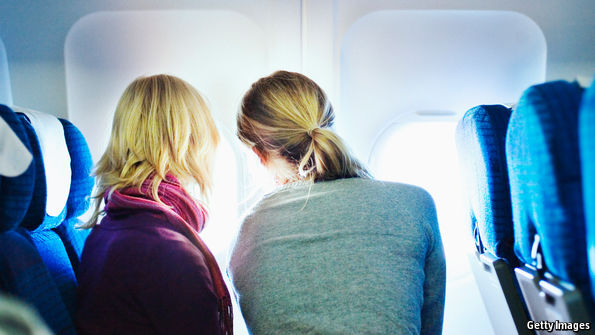
GULLIVER was just reading about Ryanair’s decision to shorten the window of time in which customers can check in before a flight, from a week to four days. The idea is to give those who are prepared to pay to reserve a particular seat more chance of success. (Pony up, and four days’ check-in time becomes a week again.)
That got him to thinking why anyone would pay to reserve a specific seat on Ryanair, given that the best ones—exit seats and the like—are sold separately. It must be people who are desperate to ensure they sit either in the aisle or by the window. This realisation then demanded its own debate on which is preferable.
It goes without saying that no one wants to be stuck in the middle seat. When travelling alone it means you have two strangers’ elbows and knees to combat. Flying en famille is just as bad. Gulliver’s young daughter insists on the window, so sitting in the middle row means hours of reading her books rather than his own. Worse, it means virtually no chance of plugging himself into some Alice Coltrane, closing his eyes and drifting…Continue reading
More airlines are banning Samsung’s smartphone

RESTRICTIONS on smartphones aboard aeroplanes have long been a bugbear of business travellers. Rules proscribing their use are slowly falling away; they might not after all, it has been decided, interfere with an aircraft’s systems. (This was discovered, coincidentally, around the same time that carriers found that they could charge for onboard Wi-Fi.) But now airlines are banning them them once again. Or at least one particular type: the Samsung Galaxy Note 7
These phones, it seems, might pose a real danger to an airliner in flight. It was the Note 7’s propensity to catch fire that persuaded American authorities to ban them on American flights last week. (Back in September, some carriers had already told passengers not to re-charge them while aboard.) However, in the past few days, many other airlines around the world have followed suit. Over the weekend Japan’s transport ministry said it was prohibiting passengers from flying with the phones. Those caught trying to smuggle the devices onto carriers such as ANA would have them confiscated, it said. Emirates and Etihad are also taking a hard line, the latter insisting that «Guests must not carry Samsung Galaxy Note 7…Continue reading
Why did the Obama administration change its mind on the American Airlines-US Airways merger?
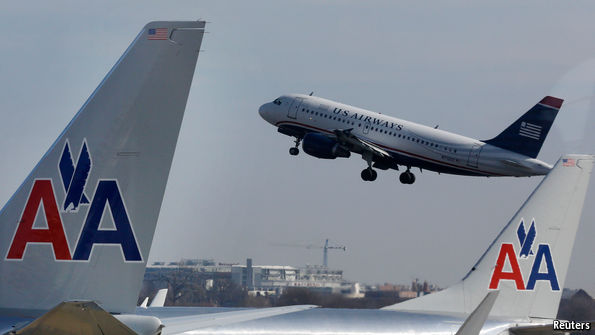
FLYERS in the United States are often frustrated by the dearth of options on certain routes, and the high price of tickets that are the result of limited competition. After several high-profile mergers in recent years, more than 80% of the domestic air market is controlled by four companies. That has led some travellers to ask how the government could possibly have allowed this to happen.
The answer is the same one that explains so many beguiling aspects of American governance: the combination of money, lobbying, influence, and the political revolving door that often makes it so easy for powerful companies to get their way.
A new investigation by ProPublica delves deeply into the complex web of meetings, donations, and hirings that surrounded the tie-up between American Airlines and US Airways. Three years ago, the administration of Barack Obama filed a lawsuit against the merger, alleging that it would raise prices and fees, cut service, and worsen amenities. Three months later, it reversed course, settling with the airlines and allowing the merger to move…Continue reading
Airlines are to cough up for cross-border flight pollution
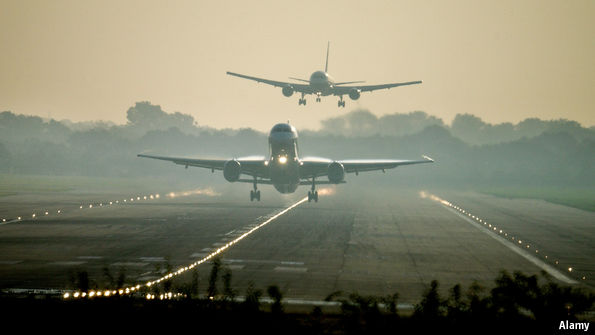
CIVIL aviation accounts for perhaps only 2% of manmade carbon emissions. Add in other pollutants, such as contrails and nitrous oxide, and the industry’s overall contribution to climate change might be twice that figure. That may not seem much. But the sector is growing rapidly. Since the 1970s, global air traffic has doubled in size about every 15 years. Rising prosperity in developing countries and massive backlogs of aircraft orders means that the growth will continue for decades. Without regulation, the world’s airlines could quickly choke the skies.
Last week, the International Civil Aviation Organisation (ICAO), a United Nations agency, announced a framework for mandatory carbon-offsetting on all international flights. The agreement was backed by 65 countries, which between them account for 86.5% of international flight operations.
International flights, unlike domestic ones, were exempt from last year’s Paris Agreement on climate change. This new tentative accord seeks…Continue reading
How to get around America without knowing how to drive

LIKE many Londoners, your correspondent does not possess a car. Thanks to the Underground, buses, taxis, shared bikes and the gift of upright bipedal motion (to say nothing of the impossibility of street parking) it has always seemed more trouble than it is worth. But unlike most other functioning adults, this Gulliver also lacks the licence—and indeed the ability—to drive.
Which made the prospect of reporting a story from deepest Florida daunting. Never mind the snakes, alligators and Florida men; without a car I worried more about negotiating America’s creaky public transport system than fending off local fauna. Few American cities outside New York offer the possibility to get around without driving. As for unincorporated towns and rural areas in poor counties? Forget it.
It is not as if I have never reported outside conurbations. But much of that reporting has been in developing countries where rented cars tend to come with people to drive them. As it turns out, Florida offers something similar.
The presence of Uber, a ride-hailing service, is…Continue reading
